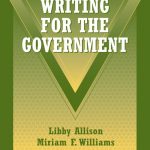Writing for the Government
$139.99
| Title | Range | Discount |
|---|---|---|
| Trade Discount | 5 + | 25% |
- Description
- Additional information
Description
The authors of Writing for Government introduce students to the diverse and interesting world of government writing by presenting and discussing a wide range of government documents and Web pages from varied agencies and organizations, producing “adaptable writers” able to write for various positions and purposes.
-
A broad scope of documents extends beyond rules and regulations to also include policy handbooks and manuals, policy memorandums and reports, and grants and proposals, as well as writing and designing government Web sites.
-
The Generous inclusion of examples throughout the text illustrates instruction and help students imagine the many writing scenarios they should prepare to encounter in their professional careers.
-
Chapter opening vignettes engage students immediately, show practical implications of government writing, and introduce the chapter genre.
-
Chapter ending activities and assignments ensure students practice applying concepts and theories to real scenarios, offering informal and formal writing opportunities, collaborative activities, and researched activities.
-
Three comprehensive case studies on the Southwest Florida Water Management District, Hurricane Katrina, and The National Multiple Sclerosis Society showcase the many different genres of government writing that can be generated by one agency or on one topic.
-
Extensive coverage of writing government Web sites addresses the ways that writing for the Web differs from writing print documents in terms of audience demographics and expectations, narrative style and structure, and duration of efficacy.
Writing for the Government blends experience-based theory with actual workplace applications from a wide range of fields and documents to prepare readers for positions in government.
Taking a rhetorical approach to writing, the authors encourage students to consider every document’s audience, purpose, and cultural context and increase the effectiveness of their communication. Writing is also presented as a process, particularly collaborative, in which authors have a stake in the outcome. The purpose is to prepare students to become “adaptable” writers regardless of their job, their agency, or its writing tasks.
Foreword by Series Editor Sam Dragga
Preface
Part One: Government Writing: Theory, Principles, and Ethics
Chapter One: Introduction
Principles and Approaches
Audience, Purpose, and Cultural Context
Knowing an Audience
Demographics of an Audience
Level of Knowledge and Expertise of an Audience
Professional and Personal Needs of an Audience
How Government Writers Get to Know Their Audience(s)
Summary and Looking Forward
Activities and Assignments
Works Cited
Chapter Two: Purpose and Cultural Context
Process Writing, Social Interchange, and Cultural Contexts
Purpose in Writing
Purpose and Genres
Discourse Conventions in Government Writing
Genres and Discourse Conventions
Ethical Issues in Cultural Contexts
Social and Cultural Ethics
Plagiarism, Copyright, and Other Ethical Matters
Style Guides
Technological Factors
Organizational Culture and Ethics
Personal Ethics and Government Writer Ethos
Summary and Looking Forward
Activities and Assignments
Works Cited
Part Two: Writing To Make Policy
Chapter Three: Rules and Regulations
The Purpose of Rules
Rules or Laws?
Rule Writing in Cultural Contexts
Audience for Rules
Collaborative Nature of Rule Writing
Stakeholders in Rule Writing
Subject Matter Experts
Legal, Fiscal, and Technology Experts
The Public
Editors
Summary and Looking Forward
Activities and Assignments
Works Cited
Chapter Four: Policy Handbooks, Manuals, and Guides
The Purpose of Government Handbooks
Policy Handbooks and Manuals in Cultural Contexts
Audience for Policy Handbooks and Manuals
Style Guides and Organization of Policy Handbooks
Handbook Cover
Overview, Foreword, or Preface
Body
References, Glossaries, Appendices, and Indexes
Government Agency Style Guides
Collaborative Nature of Handbook Writing
Writing, Editing, and Publishing Policy Handbooks
Summary and Looking Forward
Activities and Assignments
Works Cited
Chapter Five: Policy Memorandums
Purpose of Policy Memos
Policy Memos in Cultural Contexts
Memorandum of Understanding—“Across Jurisdictions”
Audience for Policy Memos
Components of Persuasive Policy Memorandums
Summary and Looking Forward
Activities and Assignments
Works Cited
Part Three: Writing to Communicate Policy Issues to Agencies and the Public
Chapter Six: Public Policy Reports
Purpose of Government Policy Reports
Government Policy Reports Investigate a Problem
Government Policy Reports Explain Past Events or Results of Inquiry
Government Policy Reports Serve as Tools for Advocacy
Government Policy Reports Prescribe Steps for Policy Implementation and Enforcement
Government Policy Reports in Cultural Contexts
Economic Constraints
Sociopolitical Constraints
National Security Constraints
Scientific and Technological Constraints
Audience for Government Policy Reports
Components of Government Reports
Summary and Looking Forward
Activities and Assignments
Works Cited
Chapter Seven: Government Grants and Proposals
Purpose of Government Grants and Grant Proposals
Grants in Aid
Funding the Public
Grant Proposals
Proposal Writing in Cultural Contexts
Adherence to Strict and Complex Guidelines
Competitive Nature of Proposal Writing
Length and Complexity of the Proposal Development Process
Personal Accountability and Ethical Dilemmas
Audience for Government Proposals
Summary and Looking Forward
Activities and Assignments
Works Cited
Chapter Eight: Government Websites
Audience, Purpose, and Cultural Contexts
Genre and Purpose
Genres of Websites
Purposes
Writing Website Content
How Users Read Websites
Readability Analysis of Websites
Plain Language Movement
Languages Other than English
Writing Techniques for the Web
Chunking Style of Writing
Card Sorting as Organizing
Chunking and Sorting Activity Example
Content Writing, Visual Thinking, and Headings
Methods of Getting to Know Your Audience and Their Needs
Feedback, Usability, and Personas
Usability Testing
Personas
Applying Personas
Information Architecture
Site Indexes and Maps
Content Inventory
Content Management Systems (CMS)
Technology Inventory
Code
Reading HTML
Design Inventory
The Homepage
Visual Displays
Charts
Drawings
Graphs
Maps
Tables
Multimedia
Style Guides and Templates
Style Guides
Style Sheets
Cascading Style Sheets (CSS)
Templates
Legal and Ethical Inventory
Accessibility
Other Requirements and “Best Practices”
Other Important Legal and Ethical Matters
Government Websites in the Future
Activities and Assignments
Works Cited
Part Four: Case Studies
Case Study One: Hurricane Katrina
Activities and Assignments
Works Cited
Case Study Two: Southwest Florida Water Management District
Activities and Assignments
Works Cited
Case Study Three: The Nonprofit Organization and Government Documents: The National Multiple Sclerosis Society
Activities and Assignments
Resource List for Nonprofits and Legislative Advocacy
Works Cited
Appendix: List of Federal Departments and Agencies
Glossary
Index
Additional information
| Dimensions | 0.80 × 7.40 × 9.00 in |
|---|---|
| Imprint | |
| Format | |
| ISBN-13 | |
| ISBN-10 | |
| Author | |
| Subjects | english, composition, higher education, Language Arts / Literacy, Technical Communication |




